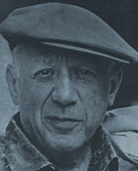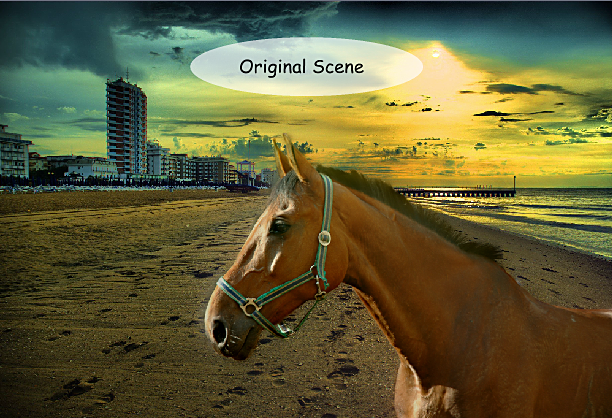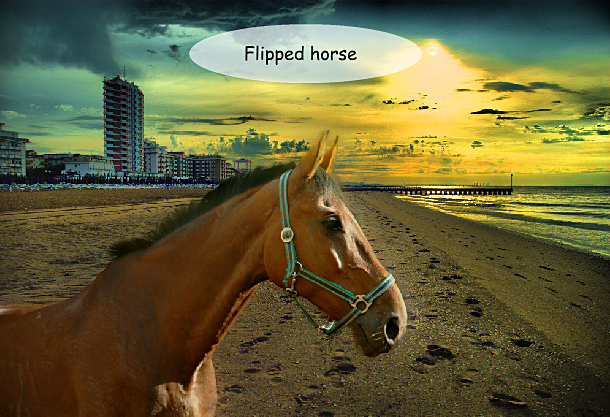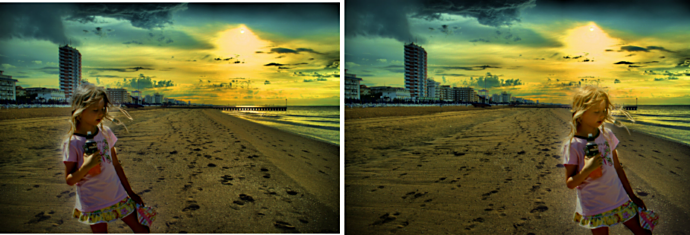Composing is telling a story.

Pablo Picasso
Pablo Picasso had very interesting way of dynamically painting his images. He would for example paint a couple walking on a beach, then he would repaint the image with what happened next in the story: maybe the man saw someone new and left. Then he will repaint the whole image again with the man missing from the image and only his girlfriend standing there sadly. Then he may repaint the whole thing once again where even the girlfriend has left and we are looking at an empty beach.
The painting was a way for him to tell a story. Obviously Picasso was also the main and one could say the only real spectator of the story. Now if we would see this fictional painting with an empty beach we may just wonder what actually happened there. Why nobody is there?
Picasso could afford to entertain himself because he was already famous and as with any good painter, not necessary "like other people".
However the simple fact of me standing on the very opposite end of being a famous painter gives me actually the same benefit! Doing things just for fun would, similarly to Picasso, not change anything about the value of our art.
Picasso would always sell his paintings for a huge sum of money and I would never sell a single scribble.
The lesson of this is that no matter what, the photo, composition, painting should always tell some sort of a story. While the story may not be always obvious to the viewers, it should at least engage them into figuring it out. And similarly to Picasso if we are genuine about our art, every viewer will take something different as the story from our image.
This flows into another thing I want to talk about: a snapshot.
Today, a single image using digital camera cost nothing. When I started, I had 12 images on my 6x6 roll of film. I had to spend an hour to develop the film by myself, then another few hours in the dark room to make a photos. And I need to buy and mix the chemicals.
There was simply no place for a snapshot on my 12 image roll. Every frame had to count.
A snapshot is just that, nothing particular. We see a nice building, snap! Something over there, snap! Why is this thing green? Snap!
Snapshot doesn't tell any story, it is a single frame from a very long story of someone else. The Story is not only unknown to any potential viewer but also to us.
Unlike the fictional Picassos empty beach I made up, viewer doesn't even put any effort in figuring the story out because he knows deep down there is none to begin with.
By making compositions we have the power to change reality and to engage ourselves into the story.
I was playing with my 7 years old daughter with an early release of Photo Blend. She couldn't stop laughing. We created a pink horse with a big nose with her picture in foreground and a jungle scene we took in a miniature world in Victoria this summer in the background. For here it was all about the story what happened in the image, what the horse was saying to her about being pink, why she needs to make his eyes bigger etc...
So after all this talk about story importance and such, let's just go back to earth and to our horse on a beach, shall we?


Secret art of scene composition is all about our learned customs.
When the horse was on the right side as it was in our original scene, it was coming out of the sea. We may not immediately notice this but our brain does. The horse is simply leaving. And that invoke a bit sad feeling as in saying good bye. It is better to come to beach than leave.
When the horse is on the left side looking out to sea as on the second image above our brain tells us that it is arriving and that invokes a happy feeling and expectations. Like a visit from your aunt which means lots of cookies, home made wine and roasted turkey and grandpa singing Marseilles till midnight.

Lets explore another set of emotions, this time I will flip each picture around even with the backdrop:

Now the horse is still leaving and arriving on the beach but it is doing it from other side now. How does it differ from previous images? Why it doesn't evoke the same emotions?
Here, at least in the west we read things from left to right.
This movement is hard-coded in our brain. Left to right is the movement forward. Right to left means for our brain going backward. A first letter on a page is at top left, last one is at bottom right.
(This would be however different for people who read from right to left.)
Therefore the first set of images (Arriving and Leaving) invoke far stronger and clear emotion for westerners.
The horse is moving read-forward (positive) AND it is going to the beach (positive). The horse is moving read-backward (negative) AND it is leaving the beach (negative). It is clear, one is arriving, the other one is leaving. One gives our brain positive vibrations, the other negative. Both are clear.
The second set of pictures gives the western brain a bit of conflict of emotions. The horse is going read-forward (positive) BUT leaving the beach (negative). (Something happened there?) On the other image the horse is arriving at the beach (positive) BUT in a read-backward way (negative) (Can't decide? Should it go or not?)
So from all the four combinations the very first one (and here is the big proof of the western trained brain again, if I say first one, you automatically look at the top left image, if I tell this to someone who reads right to left he will probably look at the top right image) so the one on top left is the best composition as to give the viewer happiest feelings.
I told you I can squeeze a lot from flipping one horse around few times.
Interestingly flipping the horse vertically upside down would send the same signal to everyone, western or not.
Composition Error
There is also very obvious composition error that I am not even sure I have to even mention, but I see it all the time in amateur photography.
It is a person entering and exiting frame. For all the social and esthetic reasons, we want the person to walk towards the center of the frame like in the left image not out of the frame as in the right image.
The right image is like a novel where the author forgot to write the first half. The girl is exiting the frame, the story now ends, but there is nothing else in the image that would tell us "why?".
